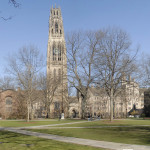by Jessica Yuan, YC’15
When I was in elementary school, I thought it was normal when other kids would pull their eyes into slits at me. I did it back because I thought it was a game, like a high five or secret friendship handshake. There was also the one where you pulled your eyelids up for Chinese, straight to the sides for Japanese, and down for Korean. Everyone did it at each other, the Asian kids too, and we all had a couple of laughs and a great time.
I did this to my own eyes in the mirror yesterday to see if I remembered it correctly, and I burst out crying. I saw how easy it was for me to be caricatured, dehumanized, trapped in violently reductive representation. I wanted to show my friends, to expose this, and also I wanted to hide it forever so they would never see me this way.
How many of us have experienced things like this? We played “cops and robbers” and the robbers “just happened” to be Black children. We played “cowboys and Indians” not knowing the trauma of reenacting Indigenous genocide. I hope that most of us would have a hard time describing this as “harmless” play, as an exercise in creativity. This is not the blank slate of childhood imagination at work. These children are mirroring the racist ideology of the world they have been socialized into.
One Thanksgiving, in third grade, we made paper hats, black paper buckle hats for the Pilgrims, and paper feather headdresses for the Native Americans. Everyone wanted to be a pilgrim so the teacher had to assign who got to wear a buckle hat and who wore a headdress. It’s been close to 15 years so I can’t say whether she made this division based on any conscious or unconscious racial bias but yeah, you’d cringe at the class photo. All I remember is really wanting to be a pilgrim, really wanting to be on the winning side of American history. I was eight years old, and I had a teacher who encouraged us to appropriate indigenous culture, who encountered children with such a deeply internalized white supremacy that they would rather dress as white settlers.
It seemed so normal to me that all the children of color I knew, all my friends, wanted to be white. One of my Asian girl friends told me about trying to cut a double eyelid into her face with a butter knife. I remember being five and asking my mom why my scars were lighter than the rest of my skin. I imagined peeling and scraping off my yellow, strip by strip until my body came out white. I hear stories of young girls asking their mothers to pour bleach in the bathtub, of not playing sports because they didn’t want to get tan. And to five year old me, this was not a violent thought, and it was not self-hatred. It was normal because whiteness is normal.
So much incredible academic work has been done on the experiences of children of color — in particular I owe so much to Anne Anlin Cheng’s “The Melancholy of Race.” And we should all know about Kenneth and Mamie Clark’s doll experiments, where Black children preferred to play with and identified more strongly with white dolls. And all of us growing up in the nineties watched TV with mostly white characters and white stories (with casually stereotyped people of color) and we grew up identifying with white heroes, imagining ourselves as white heroines. As long as systemic racism continues, the realm of childhood imagination will also be a white world. When we accept this, we permit future generations to denigrate people of color, to accept a white supremacist version of history, andto refuse to think critically about race. To end racism, we must give space to our children of color, space for them to celebrate who they are, to be represented fairly, to grow up feeling fully human.
To end the story, it took me a long time to wake up, so long I’m embarrassed sometimes. When I came to Yale, I didn’t know when my screw dates were fetishizing me as an Asian woman, and I took it as a compliment instead. I wasn’t interested in social justice. I used skin lightening cream (Fair & Lovely, ughhhhhh) until my sophomore year. I stayed neutral and passive, like so many Asian Americans and second generation Americans, because we were made to accept these things in order to assimilate. I want to apologize for the way I acted before I became conscious of these things, when I perpetuated white supremacy and heteronormativity because of internalized racism and sexism. And I need to thank the people who helped me grow up. I want to thank the brilliant women of color who pointed out things that I would’ve just taken silently, who got offended for me, who fought for me until I knew enough to fight for myself.
Before any of us became Ivy League students of color, before any of us became courageous critical thinkers, we were yellow, Black, and brown children confronting a world that we trusted to respect and love us. So we grew up trusting a world that was fundamentally racist and sexist in its roots. We were taught a history that erases us, that misrepresents us and trivializes our suffering. We accepted as normative a world that marginalized us, and we thought it was harmless because that is what children do. This is why it takes a lifetime to decolonize ourselves.




Thank you.
Elisia Ceballo-Countrymam’s grandmom.
You say others have helped you along and pointed out things that were just taken silently – you did that for me. Thank you. I especially appreciated this as you put into words something I’ve experienced for a very long time and just simply didn’t have the guts not the words to out it into being: “I want to apologize for the way I acted before I became conscious of these things, when I perpetuated white supremacy and heteronormativity because of internalized racism and sexism.” Thank you so much. Great piece. Please, keep writing!
This is a really beautiful and brave piece. The imagery is so powerful, that I am taken back to my own childhood. It’s simply breathtaking. Thank you for sharing such a personal, yet common experience.